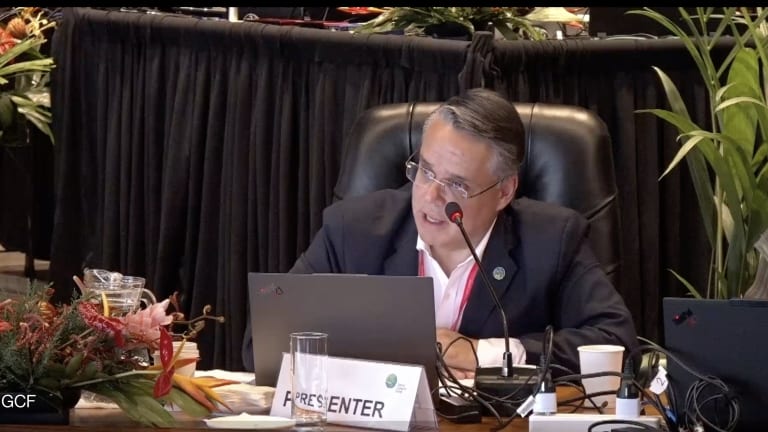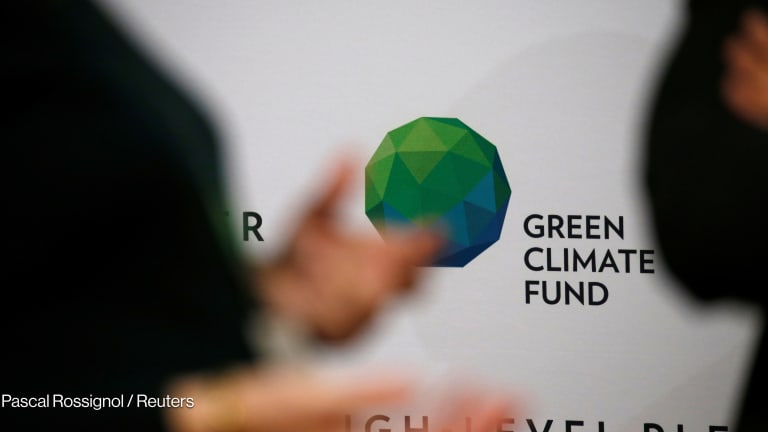What's next for the Green Climate Fund?
The Green Climate Fund is suddenly worth $9.3 billion. Here's what prospective partners need to know about it.
A week after U.S. President Obama announced his $3 billion commitment to the Green Climate Fund, major contributions have rushed in to a multilateral fund for climate change projects that has, until now, been more of an idea than a reality. At Thursday’s pledging conference, 30 countries — including the United States — formally committed to provide $9.3 billion to GCF. Organizations and implementing agencies now have to grapple with what it will mean to partner with the GCF, what kind of regulations grantees are likely to face, and what kinds of projects the fund will support. Here’s what you need to know: What will it fund? The Green Climate Fund is a financing mechanism intended to pool resources between developed and developing countries so that developing countries can gain more resources to meet the demands of addressing climate change. The fund will work between implementers and intermediators — multilateral institutions or national banks — in the areas of mitigation and adaptation, which will each receive 50 percent of funding. That even split that could help balance out what has so far been a greater multilateral focus on financing mitigation, Alex Doukas, a research analyst at World Resource Institute’s finance center, told Devex. The initial list of projects to be funded include those related to clean energy access, energy efficiency in buildings and appliances, sustainable cities, community-based adaptation, and early warning and risk management systems. The board — comprising 24 members, divided evenly between developing and developed countries — will determine which institutions are accredited and how to prioritize investments. How will accreditation and funding work? The fund will have a “fit-for-purpose” approach to accreditation so that institutions applying will be considered based on the amount they wish to withdraw and for which types of projects. “Actors seeking to access $100 million for infrastructure projects based on concessional loans and grants will be assessed at a higher standard than those looking to access $5 million for grant-based capacity building workshops for farmers, for example, due to the higher risk involved,” the WRI analyst said. Though none are accredited yet, Doukas said the first institutions could be accredited as early as February during the next board meeting in South Korea. Institutions already accredited with the Global Environment Facility or Adaptation Fund — older climate financing partnerships — are eligible for “fast track GCF accreditation.” The board will prioritize investments based on their potential to achieve emissions reductions or contribute to the transformation of economic sectors in a sustainable, long-term way. While funding for readiness activities — helping countries prepare for proposals, strengthening national designated authorities and helping national institutions that are potential implementers be accredited — has started to flow, the big money for project implementation is expected to come in the third and fourth quarters of next year. How procurement will work has yet to be determined, as there are differing views among members of the board. “It could take the form of regular RFPs or open calls with proposals coming in,” Doukas said. A brewing safeguards and oversight controversy? Safeguards and oversight of the fund have been a contentious issue. The ultimate goal is for the GCF’s policies to reflect other climate funds’ best practices — those of the World Bank Climate Investment Fund, in particular, since GCF is intended to replace that fund as it phases out. Civil society advocates, however, said that current interim safeguards in place at the GCF are insufficient. The fund has so far adopted the International Finance Corp.’s performance standards, which have been criticized by some groups for not sufficiently addressing human rights or projects’ impact on indigenous communities and natural habitats. “The interim safeguards don’t reflect best practices,” Niranjali Amerasinghe, director of the Center for International Law’s climate and energy program, told Devex. “There needs to be respect for human rights in implementing activities. There needs to be free, prior and informed consent for indigenous people before big projects begin.” She also said the approach to monitoring is ambiguous, with unclear responsibilities between GCF and beneficiaries. As it stands, there is no established monitoring framework, Amerasinghe noted, adding that she hopes this is clarified before funds are distributed. Unique focus on the private sector? The GCF will include a special unit to engage the private sector — or “private sector facility” — according to Brandon Wu, senior policy analyst at ActionAid who serves as one of two civil society representatives on the GCF board. This unit will aim to mobilize funds from the global private sector, and some corporate representatives are already following funds to see where they can step in. “Unlike other funds, the GCF has engagement with the private sector at its very core,” said Abyd Karmali, managing director of climate markets at Bank of America Merrill Lynch. “By deploying the right kinds of instruments … GCF can help mobilize billions of dollars from the private sector into new low-carbon business opportunities.” Wu said the unit will also try to engage the private sector at the local level and strive to support small and medium enterprises in developing countries, which could open opportunities for microentrepreneurs. “What is exciting is looking specifically at local private actors. There could be direct small grants to SMEs through local or national banks or improving policy for SMEs to address climate change,” Karmali said. What is its comparative advantage over other funding mechanisms? GCF is unique, according to Wu, because it addresses the issue at the core of global climate discussion: What actions developing countries will take and how much support they will have to do so. “Climate finance is an integral part of the architecture of a global climate regime, and we recognize that a lot of developing countries don’t have capacity to do things that we’re asking to address climate change, and it’s not really fair to expect they take these actions without support,” Wu said. The GCF will look to bridge this gap, not only through a balanced governing body, but also with more accreditation to national and regional banks in developing countries, so that they can gain financing needed to fund green projects. “The board members want broader stakeholder engagement — to accredit more national and regional development banks that have capacity and a list of activities for which they’re looking to get support,” WRI’s Doukas said, listing the People’s Survival Fund in the Philippines as an example. What comes next? The GCF has met some early success; developing countries such as Mexico, Indonesia and South Korea with no legal obligation to contribute to the fund have chosen to do so. A big question moving forward, according to Wu, is whether the GCF will be sufficient for developing countries, which voiced a desire for $15 billion in the fund by COP21 in Lima, Peru, next month. For Wu, the GCF is only a “Band-Aid” solution, noting that even $15 billion “isn’t anywhere close” to what developing countries need to address climate change. Nonetheless, whether the $9.3 billion expected to fill GCF’s coffer will be acceptable will certainly be a question in the COP21 negotiations. Check out more practical business and development advice online, and subscribe to Money Matters to receive the latest contract award and shortlist announcements, and procurement and fundraising news.
A week after U.S. President Obama announced his $3 billion commitment to the Green Climate Fund, major contributions have rushed in to a multilateral fund for climate change projects that has, until now, been more of an idea than a reality.
At Thursday’s pledging conference, 30 countries — including the United States — formally committed to provide $9.3 billion to GCF.
Organizations and implementing agencies now have to grapple with what it will mean to partner with the GCF, what kind of regulations grantees are likely to face, and what kinds of projects the fund will support. Here’s what you need to know:
This story is forDevex Promembers
Unlock this story now with a 15-day free trial of Devex Pro.
With a Devex Pro subscription you'll get access to deeper analysis and exclusive insights from our reporters and analysts.
Start my free trialRequest a group subscription Printing articles to share with others is a breach of our terms and conditions and copyright policy. Please use the sharing options on the left side of the article. Devex Pro members may share up to 10 articles per month using the Pro share tool ( ).
Claire is a journalist passionate about all things development, with a particular interest in labor, having worked previously for the Indonesia-based International Labor Organization. She has experience reporting in Cambodia, Nicaragua and Burma, and is happy to be immersed in the action of D.C. Claire is a master's candidate in development economics at the George Washington Elliott School of International Affairs and received her bachelor's degree in political philosophy from the College of the Holy Cross.








